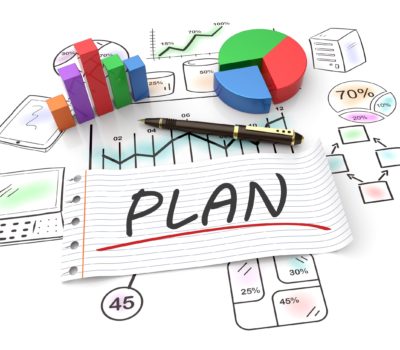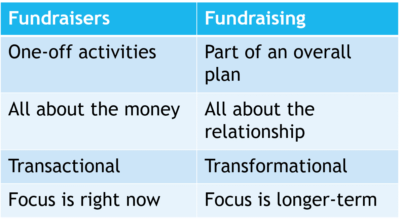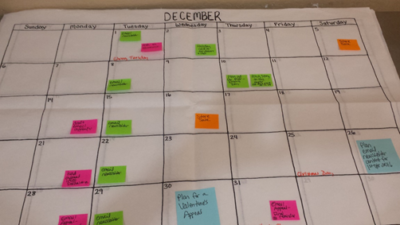The Operational Plan How To Create A Yearlong Fundraising Plan

Grab This Fundraising Plan Template for New Nonprofits
 If you're starting a new nonprofit, you already know that you need to raise money. What you might not know is that the right fundraising plan template can make the job much easier.
If you're starting a new nonprofit, you already know that you need to raise money. What you might not know is that the right fundraising plan template can make the job much easier.
In the beginning you may self-fund your fledgling organization. (Many founders do.)
Or you may ask your friends, coworkers, and family to give a few bucks.
But long term, you can't run an entire organization from the generosity of only a handful of people. And unless you're independently wealthy with an endless revenue stream, you can't self-fund forever (nor should you – more on that in a minute).
What this means is that over time, your fundraising approach should change to meet the needs of your growing organization.
The bottom line: you need a fundraising plan built on the right fundraising plan template — one that outlines goals, actions, and the specific results you want.
What Fundraising Plan Template is Right For YOU?
No two nonprofits are exactly alike.
And no two fundraising plans should be exactly alike either.
That means you need a fundraising plan template that meets YOUR needs, plays to YOUR strengths, and helps you reach YOUR goals.
Ideally, your fundraising plan should include your overall fundraising goal and the strategies you plan to use to reach that goal.
Your fundraising plan should include a detailed activities calendar showing all the various ways you plan to generate funds during the year.
Your plan should also include what you'll do when you're NOT asking for money like donor communications, stewardship, and warm touches — all designed to give the donor a GREAT experience.
The more detail you include in your fundraising plan, the easier fundraising will be throughout the year because you'll always know what to do next with no more guessing or DIY disasters.
The Challenge of Fundraising Planning for New Nonprofits
 Established nonprofits have an advantage in planning for fundraising — they can build their fundraising plan based on their numbers from prior years.
Established nonprofits have an advantage in planning for fundraising — they can build their fundraising plan based on their numbers from prior years.
In short, they can see what worked and what didn't, and use that to decide what to do in the coming year.
They also have the benefit of knowing their donors, including the reasons why people give and what they're passionate about.
As a new nonprofit, you don't have these benefits.
But fear not – you can use this to your advantage!
Since this is your first year, you won't have any "but that's how we did it last year" to deal with. You can start with a clean slate and build the fundraising plan you want.
You also have the chance to start identifying ideal donor prospects and create a plan for finding them in the community.
The good thing is, you can take the time now to develop the voice of your organization and define your brand. These are two key elements that'll form the basis for fundraising.
All of these will get you started on the right foot for donor-based fundraising, which is the best way to create fundraising revenue you can count on.
Remember that in the early months of your nonprofit, you are essentially "training" your supporters about what they can expect from you.
That makes this a great opportunity to purposefully decide how you want your new nonprofit to be seen.
Fundraising Planning When You Are New to Fundraising
No one starts a nonprofit to raise money.
You started yours to make a difference.
Then you figured out that you needed funds to pay for the good work.
When you come to nonprofit leadership with no fundraising experience it makes planning tough.
That's why having the right fundraising plan template can save you time, money, and headache!
Lucky for you, fundraising planning is a skill that can be learned, and it won't be long before you're on your way. (Hey, just stick around and keep reading this blog and you'll learn A LOT!)
The key to success in fundraising is to be curious.
That means learn everything you can about how donor-based fundraising works so you can draft a fundraising plan to create that kind of revenue for your nonprofit.
As you plan, you may come up with good ideas that seem impossible to implement.
That's when you'll need to get creative and think outside the box.
Anytime you see or feel a hurdle in front of you, look for options.
Don't say "we can't do that." Say "HOW can we do that?"
Asking the right question can help you jump that hurdle or find a way around.
Even if You Can Self Fund, You Shouldn't
In the early days of your nonprofit, you may be tempted to self fund (pay for everything yourself).
It might be your only option. And that's ok.
If you're fortunate enough to have the resources to support your nonprofit, that's wonderful and it's a great thing to know that you have that in your back pocket.
But that's where you should keep it.
Why?
 There's an old saying that "if you want to go fast, go alone. If you want to go far, go together."
There's an old saying that "if you want to go fast, go alone. If you want to go far, go together."
That means that there's only so much you can do by yourself.
You NEED the support of people who are excited about the work your nonprofit will do.
And the more of those people you have around you, the more revenue you'll have and the more lives you can change.
Plus, you'll experience less stress because you'll know you have financial supporters who always have your back.
So, be sure to build in activities into your fundraising plan to find more of these ideal donors.
You see, people want to help and they want to feel like they're a PART of something that matters.
Self-funding and just sharing results with your followers is robbing them of the opportunity to be a part of the team!
You're basically taking away the opportunity for them to invest both emotionally and financially.
Many supporters feel a real connection when they send that donation. Their gift helps fulfill their personal philanthropic goals.
So, by all means, find people who are most likely to care about your cause and give them the chance to give.
Let's Build Your Fundraising Plan!
Okay, it's time to draft your plan. Are you ready??
Step 1: Set a Fundraising Goal
 This seems so obvious, but many times, we can't see the forest for the trees!
This seems so obvious, but many times, we can't see the forest for the trees!Having an open call for donations just to help your organization may work a few years down the road once you've developed a strong support base, but as a new nonprofit it won't garner much results.
It also doesn't work to blindly ask people to give when you can't tell them how the money will be used.
In other words, don't try to raise as much as you can then figure out how to spend it.
Start by mapping out what programs and services you plan to offer during the year. You need to figure out:
- What are you trying to provide?
- How many will you serve?
- What will be the impact?
- How much will it cost?
Plan Your Programs FIRST: You need to plan your programs for the year before you set your fundraising goal.
What specifically are you doing to accomplish your mission? Think in terms of action.
It's not enough to say you want to make sure children don't go hungry. You have to be more specific. You want to provide X number of meals to X number of children for X amount of time.
- What will this cost? This number is your direct program cost.
- How much do you need to run your nonprofit this year? This includes rent/ facility costs, payroll, admin, fundraising, phones, and any other expenses you need to keep the organization's doors open. These are your operating costs.
- Add those two together to get your fundraising goal.
Direct Program Cost
+ Operating Costs
= Fundraising Goal Amount – this is how much you need for the year!
When you figure out your fundraising goal down to the penny, you can build a fundraising plan to help you reach that goal without guessing.
Step 2: Choose the RIGHT Fundraising Strategies
When your nonprofit is new, it's easy to grab at any opportunity for some quick cash.
You might get really excited about restaurant nights, candle parties, t-shirt sales, or voting contests.
And yes, sometimes there is a place for these types of fundraisers , especially when they're planned and executed well..
But these should only be a small part of your overall fundraising strategy, and here's why:
These "transactional" fundraisers do nothing to build a relationship with your donors.
In fact, when people participate in these fundraisers, they're not really donating at all.
They're just eating at a restaurant or purchasing something for themselves, and it happens to benefit your nonprofit.
The difference between fundraisERS and fundraisING is just that: what does the person get in return?
True donor-based fundraising involves getting donations for your cause just because people believe in the work you're doing and they trust you to be responsible stewards of their hard-earned money.
Their giving is "transformational" meaning they give to make a difference, not to receive something in return.

Again, there are times when transactional fundraisers are fun and can fit into your overall fundraising plan.
Just remember that they're quick cash with no future rewards.
For a new nonprofit, the most beneficial strategy is to think longer term. Think about the kinds of fundraising activities you'll need in place to create the revenue you must have to fund your nonprofit when everything is up and running.
Choose fundraising strategies that:
- Play to your strengths personally. Don't try to do something you'll hate doing.
- Gets you the MOST bang for the buck. Don't do lots of things that only generate nickels and dimes. You may have to try several things before you figure out what works — just ditch the ineffective efforts fast.
- Are "rinse and repeatable." Do productive fundraising that can be repeated every year. Then you won't be reinventing the wheel every January.
- Builds your donor family. THE most important thing you can do as a fundraiser is to bring in new donors. So make sure the fundraising activities you're planning cannot only raise money but identify new donors, too.
- Help you take big steps toward your fundraising goal. You won't have time to use every idea you or your Board come up with, so choose ones that will bring in enough money to be really worth it.
If you're not sure what fundraising strategies to include in your fundraising plan, start with these:
-
 ONE fundraising event. You'll never fully fund your budget with lots of little events, so don't try. Hold ONE big fundraising event each year. Give it everything you've got and make it a Signature Event so everyone in town knows it's your event. Make it a FUN event that people talk about for days afterward. And make sure it makes you plenty of money (at least 4 times what you spend) so it's worth the effort. Lots of little events throughout the year are exhausting for you, your volunteers, and the community, so focus on just one. Then, move on to other things.
ONE fundraising event. You'll never fully fund your budget with lots of little events, so don't try. Hold ONE big fundraising event each year. Give it everything you've got and make it a Signature Event so everyone in town knows it's your event. Make it a FUN event that people talk about for days afterward. And make sure it makes you plenty of money (at least 4 times what you spend) so it's worth the effort. Lots of little events throughout the year are exhausting for you, your volunteers, and the community, so focus on just one. Then, move on to other things. - Smaller online campaigns. You can use really powerful messaging, photos, and videos to show the need and how your programs will meet that need, even if you haven't gotten started yet. Small online campaigns are great for educating followers and bringing in new donors. Start small with a modest goal so you can have a win. Over time you'll realize that you can grow these efforts and ask for more as the general public builds their trust in you.
- Monthly giving. NEVER underestimate the power of small monthly donations. It may not seem like much at first to receive a $10 monthly gift, but over the year that's $120. That's way more than you would get if that same person bought a t-shirt or ate a spaghetti dinner. Also, studies show that monthly donors are far more likely to leave something to the charities they support in their wills or estates. Think long game and treasure the folks that give each month, no matter the amount!
- Periodic appeals. If you want to raise money like the pros do, build a donor base and ASK people to give two or three times during the year using a powerful appeal (aka fundraising letter). The more people you have in your donor family and the better job you do of giving them a great experience when they give, the more money you can raise and the easier it will be. Yes, there's both art and science to a good appeal, and you can learn how to do it in a way that motivates people to give.
If you plan to set up an Amazon Smile account or enroll in a grocery store affinity card program or something similar, be sure to include times in your fundraising plan when you'll promote these.
These Strategies Can Be Unproductive At First
In your first year or two, you'll spend a lot of time testing fundraising strategies to see what works and what doesn't.
You may have a few ideas of where to start raising money, and if they include any of these, you may want to think again.
- GoFundMe or other crowdfunding sites. No one wakes up in the morning and says "Gee, I feel like giving some money away. I think I'll find a good one online!" You can set up a GoFundMe campaign, but you'll still need to drive traffic to that site to get people to give.
- Grants. Grants are not a good option for new nonprofits because 99% of funders want to see several years' worth of data showing the impact your programs have. You simply don't have the history as a brand-new nonprofit. So skip grants until you reach year 3 or 4 and are grant ready.
- "Rich people." People don't give based on their wealth. They give based on their interest and your value. Targeting "rich people" is a waste of time. Just because they have money doesn't mean they'll give to charity, and if they're philanthropic, they probably have a favorite cause (and that may or may not be YOUR cause).
- Social media. Yes, you need to create social media accounts for your new nonprofit, but it takes time to build the audience. And you need a decent-sized audience before you'll raise decent money from Facebook.
Crowdfunding, grants, and social media will work for you later. But right now, they probably won't generate the results you're looking for.
Step 3. Chunk It Up and Write It Down!
Once you've chosen the fundraising strategies you want to use, it's time to get everything in writing.
Because if the plan isn't in writing, it isn't real.
You need two main pieces for your fundraising plan: a yearly calendar and a 90-day action plan.
 Yearly calendar: This can be a simple calendar or spreadsheet listing every fundraising effort you want to make, including things like Giving Tuesday or another giving day in your state, Year-End fundraising, an annual event, or a specific effort at a certain time of year. Once you have your year of fundraising mapped out, each fundraising effort should have its own 90-day action plan.
Yearly calendar: This can be a simple calendar or spreadsheet listing every fundraising effort you want to make, including things like Giving Tuesday or another giving day in your state, Year-End fundraising, an annual event, or a specific effort at a certain time of year. Once you have your year of fundraising mapped out, each fundraising effort should have its own 90-day action plan.
A 90-day action plan allows you to break your year down into smaller segments of time that feel much more manageable. It also helps you to think through the tasks that need to be completed for each fundraising effort — further breaking things into smaller bites that are easier to plan for and that you can hopefully delegate or get help with. Plus, life changes FAST, and you'll need to be able to adjust quickly.
To create a 90-day action plan, start at the date of the event and work backwards. What should be completed a week before that event? What about 2 weeks, or a month before? Is there printing to be ordered? Any other initiative that requires lead time? These are the things that are commonly overlooked, but really important for a professional event. So start mapping it out and you won't let these things fall through the cracks!
In your 90-day action plan, identify each separate task to be completed, a due date or deadline, and who will get it done. That will help make sure you stay on schedule for getting things done on-time.
Sometimes, creating your 90-day action plan with good old-fashioned paper, markers, and stickies is really helpful. I like sticky notes because if you change your mind during the planning process about where something goes, it's no big deal to move the sticky. Plus, it's fun to color-code your plan using different colored stickies or markers.
Be sure to grab the New Nonprofit's 90-Day Action Plan below!

Patience, Grasshopper
Good fundraising is built on relationships. Relationships are built on trust. And that takes time to develop.
It's not realistic to expect to raise $50,000 in 2 weeks as a new nonprofit.
You need to give people time to get to know you and understand that the work you are doing is important.
Give them time and reasons to fall in love with your mission, and the support will follow!
Additional Resources
1-Page Fundraising Plan. Download our simple annual fundraising plan template so you can see at a glance what's happening and when. www.GetFullyFunded.com/plan
New Nonprofit's 90-Day Action Plan. Get help laying out your next 90 days with these worksheets. www.GetFullyFunded.com/Action
Related Posts
The Operational Plan How To Create A Yearlong Fundraising Plan
Source: https://getfullyfunded.com/fundraising-plan-template/
Posted by: yeltonthationothe.blogspot.com

8 Comments
[…] Wild Apricot has an article about How to Prepare a Nonprofit Fundraising Plan. We especially like the section on thinking through fundraising trends. Get Fully Funded has a guide specifically for new non-profits. So if you yelled "but I don't have any past results" when you started reading this article, check out this Fundraising Plan Template for New Nonprofits. […]
The 1-Page Fundraising Plan link appears to be broken. I'd love to use it. Is anyone else having this problem?
Hi Anna, we're so sorry you are having trouble with the link. It is working on our end, but please try this link and it should work for you: https://getfullyfunded.com/plan/
I have tried several times to order the Fundraising Plan but have not been successful. I tried the link you provided on the webpage and in your comment above. Thanks.
This was such a helpful article on fundraising. It truly is a great place for me to start thank you! However, it doesn't seem like the link for the free plan is working. I keep refreshing my email and I don't see it :/